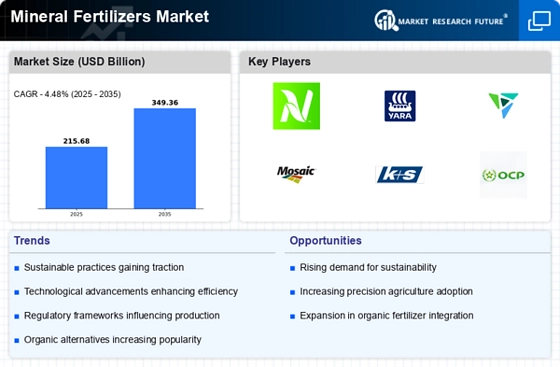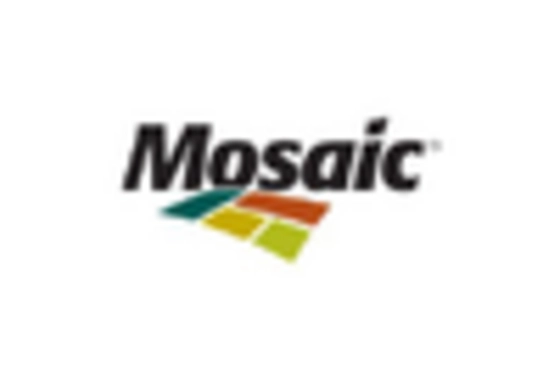Rising Food Demand
The increasing global population and changing dietary preferences are driving the demand for food production, which in turn propels the Mineral Fertilizers Market. As populations grow, the need for higher agricultural yields becomes paramount. According to recent estimates, food production must increase by approximately 70% by 2050 to meet the needs of the projected population. This surge in demand for food necessitates the use of mineral fertilizers to enhance soil fertility and crop productivity. Farmers are increasingly relying on these fertilizers to ensure that they can produce sufficient quantities of food to meet consumer needs. Consequently, the Mineral Fertilizers Market is likely to experience robust growth as agricultural practices evolve to accommodate this rising demand.
Global Trade Dynamics
The dynamics of international trade are influencing the Mineral Fertilizers Market. Trade agreements and tariffs can affect the availability and pricing of mineral fertilizers across different regions. For instance, fluctuations in the prices of raw materials, such as potash and phosphate, can lead to variations in fertilizer costs, impacting farmers' purchasing decisions. Additionally, countries that are major producers of mineral fertilizers may experience shifts in export patterns due to changing demand in importing nations. This interconnectedness of The Mineral Fertilizers Industry will continue to be affected by geopolitical factors and trade policies, which could either facilitate or hinder market growth.
Increased Investment in Agricultural Infrastructure
Investment in agricultural infrastructure is a crucial driver for the Mineral Fertilizers Market. Governments and private entities are recognizing the importance of enhancing agricultural productivity through improved infrastructure, such as irrigation systems, storage facilities, and transportation networks. These investments facilitate better access to mineral fertilizers for farmers, enabling them to optimize their crop yields. Furthermore, enhanced infrastructure can lead to more efficient supply chains, reducing costs and improving the overall effectiveness of fertilizer application. As countries prioritize agricultural development, the Mineral Fertilizers Market is poised for growth, supported by these strategic investments that aim to bolster food security and agricultural sustainability.
Technological Advancements in Fertilizer Production
Innovations in fertilizer production technology are significantly impacting the Mineral Fertilizers Market. Advanced manufacturing processes, such as controlled-release fertilizers and nano-fertilizers, are enhancing the efficiency and effectiveness of mineral fertilizers. These technologies not only improve nutrient delivery to crops but also reduce environmental impacts associated with fertilizer use. For instance, the introduction of precision application techniques allows for targeted fertilizer use, minimizing waste and optimizing crop yields. As these technologies become more widely adopted, the Mineral Fertilizers Market is expected to expand, driven by the need for sustainable agricultural practices that align with modern farming requirements.
Environmental Regulations and Sustainability Initiatives
The increasing emphasis on environmental sustainability is shaping the Mineral Fertilizers Market. Governments and regulatory bodies are implementing stricter regulations regarding fertilizer use to mitigate environmental impacts, such as soil degradation and water pollution. This trend is prompting manufacturers to develop more sustainable fertilizer options, including organic and bio-based fertilizers. The shift towards environmentally friendly practices is not only a response to regulatory pressures but also aligns with consumer preferences for sustainable food production. As a result, the Mineral Fertilizers Market is likely to see a transformation, with a growing focus on products that meet both regulatory standards and consumer expectations.


















Leave a Comment